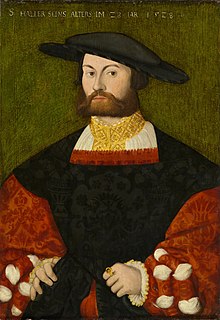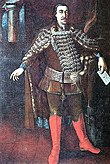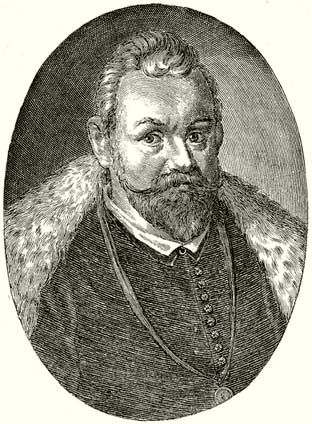
Christopher Báthory was voivode of Transylvania from 1576 to 1581. He was a younger son of Stephen Báthory of Somlyó. Christopher's career began during the reign of Queen Isabella Jagiellon, who administered the eastern territories of the Kingdom of Hungary on behalf of her son, John Sigismund Zápolya, from 1556 to 1559. He was one of the commanders of John Sigismund's army in the early 1560s.

Sigismund Báthory was Prince of Transylvania several times between 1586 and 1602, and Duke of Racibórz and Opole in Silesia in 1598. His father, Christopher Báthory, ruled Transylvania as voivode of the absent prince, Stephen Báthory. Sigismund was still a child when the Diet of Transylvania elected him voivode at his dying father's request in 1581. Initially, regency councils administered Transylvania on his behalf, but Stephen Báthory made János Ghyczy the sole regent in 1585. Sigismund adopted the title of prince after Stephen Báthory died.

The House of Báthory was an old and powerful Hungarian noble family of the Gutkeled clan. The family rose to significant influence in Central Europe during the Late Middle Ages, holding high military, administrative and ecclesiastical positions in the Kingdom of Hungary. In the early modern period, the family produced several Princes of Transylvania and one King of Poland and Grand Duke of Lithuania.

Gabriel Bethlen was Prince of Transylvania from 1613 to 1629 and Duke of Opole from 1622 to 1625. He was also King-elect of Hungary from 1620 to 1621, but he never took control of the whole kingdom. Bethlen, supported by the Ottomans, led his Calvinist principality against the Habsburgs and their Catholic allies.

Francis II Rákóczi was a Hungarian nobleman and leader of Rákóczi's War of Independence against the Habsburgs in 1703–1711 as the prince of the Estates Confederated for Liberty of the Kingdom of Hungary. He was also Prince of Transylvania, an Imperial Prince, and a member of the Order of the Golden Fleece. Today he is considered a national hero in Hungary.
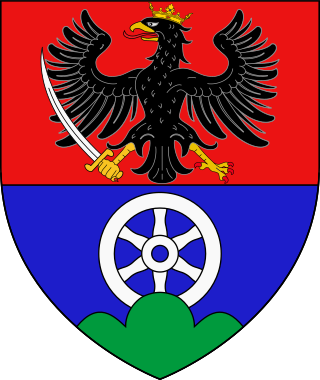
The House of Rákóczi was a Hungarian noble family in the Kingdom of Hungary between the 13th century and 18th century. Their name is also spelled Rákoci, Rakoczi and Rakoczy in some foreign sources. The family was named after Rákóc.
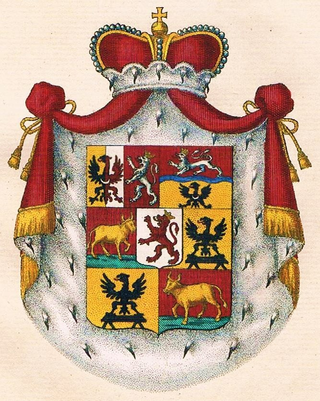
The House of Auersperg is an Austrian princely family, which once held estates in the Holy Roman Empire. The princely family of Auersperg originated as a junior branch of the comital line of Auersperg from Carniola, one of the hereditary Habsburg duchies in what is now Slovenia. The Auerspergs were raised to princely status in 1653, and they became "immediate" princes of the Holy Roman Empire in 1664. The princes of Auersperg also held at various times the duchies of Münsterberg and Gottschee. Their territories were mediatised by Austria and Baden in 1806, and the family is counted as high nobility.

Gabriel Báthory was Prince of Transylvania from 1608 to 1613. Born to the Roman Catholic branch of the Báthory family, he was closely related to four rulers of the Principality of Transylvania. His father, Stephen Báthory, held estates in the principality, but never ruled it. Being a minor when his father died in 1601, Gabriel became the ward of the childless Stephen Báthory, from the Protestant branch of the family, who converted him to Calvinism. After inheriting most of his guardian's estates in 1605, Gabriel became one of the wealthiest landowners in Transylvania and Royal Hungary.
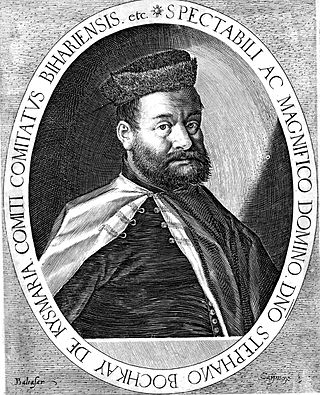
Stephen Bocskai or Bocskay was Prince of Transylvania and Hungary from 1605 to 1606. He was born to a Hungarian noble family. His father's estates were located in the eastern regions of the medieval Kingdom of Hungary, which developed into the Principality of Transylvania in the 1570s. He spent his youth in the court of the Holy Roman Emperor, Maximilian, who was also the ruler of Royal Hungary.
The Prince of Transylvania was the head of state of the Principality of Transylvania from the last decades of the 16th century until the middle of the 18th century. John Sigismund Zápolya was the first to adopt the title in 1570, but its use only became stable from 1576.
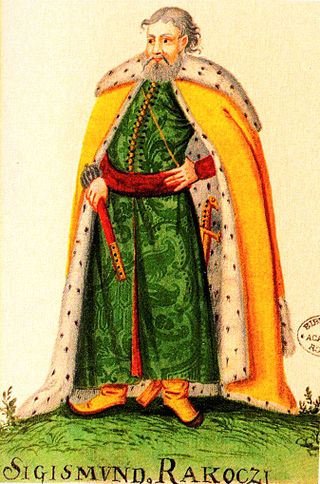
Sigismund Rákóczi was Prince of Transylvania from 1607 to 1608. He was the son of János Rákóczi, a lesser nobleman with estates in Upper Hungary. Sigismund began a military career as the sword-bearer of the wealthy Gábor Perényi in Sárospatak. After Perényi died in 1567, Sigismund served in the royal fortresses of Eger and Szendrő. The royal chamber mortgaged him several estates to compensate him for unpaid salaries. He received Szerencs in 1580, which enabled him to engage in the lucrative Tokaji wine trade. He took possession of the large estates of András Mágóchy's minor sons as their guardian, and the second husband of their mother Judit Alaghy, in 1587.

The Palanok Castle or Mukachevo Castle is a historic castle in the city of Mukacheve in the western Ukrainian oblast (province) of Zakarpattia. The Palanok Castle is delicately preserved, and is located on a 68-metre-high (223 ft) former volcanic hill. The castle complex consists of three parts: the high, middle, and low castle.
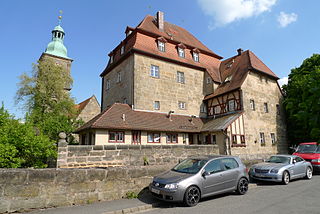
Kalchreuth is a municipality in the district of Erlangen-Höchstadt, in Bavaria, Germany. It is located 10 kilometers east of Erlangen and 15 kilometers north of Nuremberg and contains the villages of Kalchreuth, Käswasser and Röckenhof and also the hamlets of Stettenberg, Minderleinsmühle and Gabermühle.

Andrew Báthory was the Cardinal-deacon of Sant'Adriano al Foro from 1584 to 1599, Prince-Bishop of Warmia from 1589 to 1599, and Prince of Transylvania in 1599. His father was a brother of Stephen Báthory, who ruled the Polish–Lithuanian Commonwealth from 1575. He was the childless Stephen Báthory's favorite nephew. He went to Poland at his uncle's invitation in 1578 and studied at the Jesuit college in Pułtusk. He became canon in the Chapter of the Roman Catholic Diocese of Warmia in 1581, and provost of the Monastery of Miechów in 1583.

Moses Székely was Prince of Transylvania in 1603.

Francis I Rákóczi was a Hungarian aristocrat, elected prince of Transylvania and father of Hungarian national hero Francis Rákóczi II.

The Bocskai uprising, known in Hungary as Bocskai's War of Independence was a revolt which took place in Hungary, Transylvania and modern Slovakia during the Long Turkish War against Emperor Rudolf II. The rebel leader was Stephen Bocskai, a Protestant Hungarian nobleman. The Ottoman wars had burdened the Kingdom of Hungary for years, causing famine and disease, and the armies of the Christian states had been weakened by losses to Ottoman and Tatar forces.
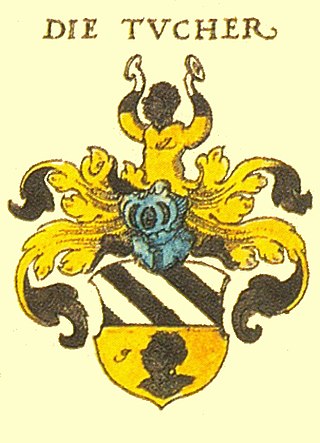
Tucher von Simmelsdorf is a noble patrician family from Nürnberg. Like the Fugger and Welser families from Augsburg, their company run trading branches across Europe between the 15th and 17th centuries, although on a somewhat smaller scale. The Protestant family played an import part in the economical and cultural development as well as in local politics. They were admitted to the governing council of the free imperial city since 1340, a hereditary privilege, and listed in the Dance Statute. After the acquisition of Simmelsdorf Castle in 1598, the family was named Tucher von Simmelsdorf and ennobled in 1697. In 1815, they became Bavarian barons.
Ruprecht Or Robert Haller von Hallerstein, (1533-1560) was a Bavarian noble lord.
Mihály Teleki, was Chancellor of Transylvania and adviser to Prince Michael I Apafi.

